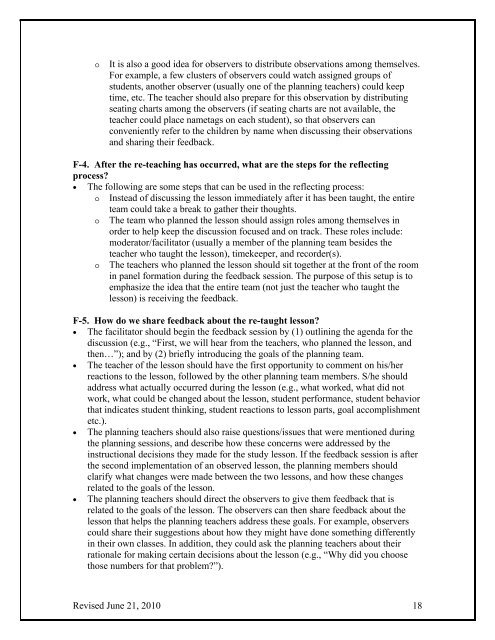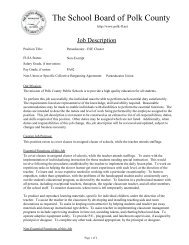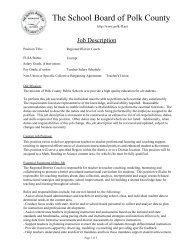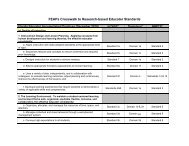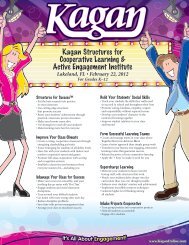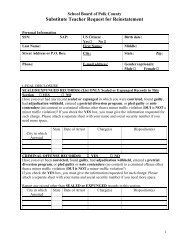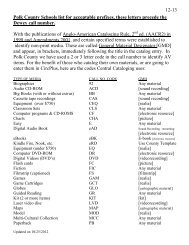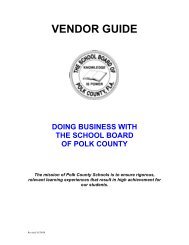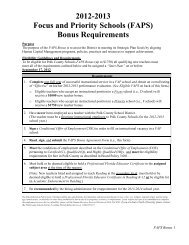FLDOE Lesson Study Guide - Polk County School District
FLDOE Lesson Study Guide - Polk County School District
FLDOE Lesson Study Guide - Polk County School District
Create successful ePaper yourself
Turn your PDF publications into a flip-book with our unique Google optimized e-Paper software.
o<br />
It is also a good idea for observers to distribute observations among themselves.<br />
For example, a few clusters of observers could watch assigned groups of<br />
students, another observer (usually one of the planning teachers) could keep<br />
time, etc. The teacher should also prepare for this observation by distributing<br />
seating charts among the observers (if seating charts are not available, the<br />
teacher could place nametags on each student), so that observers can<br />
conveniently refer to the children by name when discussing their observations<br />
and sharing their feedback.<br />
F-4. After the re-teaching has occurred, what are the steps for the reflecting<br />
process?<br />
• The following are some steps that can be used in the reflecting process:<br />
o Instead of discussing the lesson immediately after it has been taught, the entire<br />
team could take a break to gather their thoughts.<br />
o The team who planned the lesson should assign roles among themselves in<br />
order to help keep the discussion focused and on track. These roles include:<br />
moderator/facilitator (usually a member of the planning team besides the<br />
teacher who taught the lesson), timekeeper, and recorder(s).<br />
o The teachers who planned the lesson should sit together at the front of the room<br />
in panel formation during the feedback session. The purpose of this setup is to<br />
emphasize the idea that the entire team (not just the teacher who taught the<br />
lesson) is receiving the feedback.<br />
F-5. How do we share feedback about the re-taught lesson?<br />
• The facilitator should begin the feedback session by (1) outlining the agenda for the<br />
discussion (e.g., “First, we will hear from the teachers, who planned the lesson, and<br />
then…”); and by (2) briefly introducing the goals of the planning team.<br />
• The teacher of the lesson should have the first opportunity to comment on his/her<br />
reactions to the lesson, followed by the other planning team members. S/he should<br />
address what actually occurred during the lesson (e.g., what worked, what did not<br />
work, what could be changed about the lesson, student performance, student behavior<br />
that indicates student thinking, student reactions to lesson parts, goal accomplishment<br />
etc.).<br />
• The planning teachers should also raise questions/issues that were mentioned during<br />
the planning sessions, and describe how these concerns were addressed by the<br />
instructional decisions they made for the study lesson. If the feedback session is after<br />
the second implementation of an observed lesson, the planning members should<br />
clarify what changes were made between the two lessons, and how these changes<br />
related to the goals of the lesson.<br />
• The planning teachers should direct the observers to give them feedback that is<br />
related to the goals of the lesson. The observers can then share feedback about the<br />
lesson that helps the planning teachers address these goals. For example, observers<br />
could share their suggestions about how they might have done something differently<br />
in their own classes. In addition, they could ask the planning teachers about their<br />
rationale for making certain decisions about the lesson (e.g., “Why did you choose<br />
those numbers for that problem?”).<br />
Revised June 21, 2010 18


